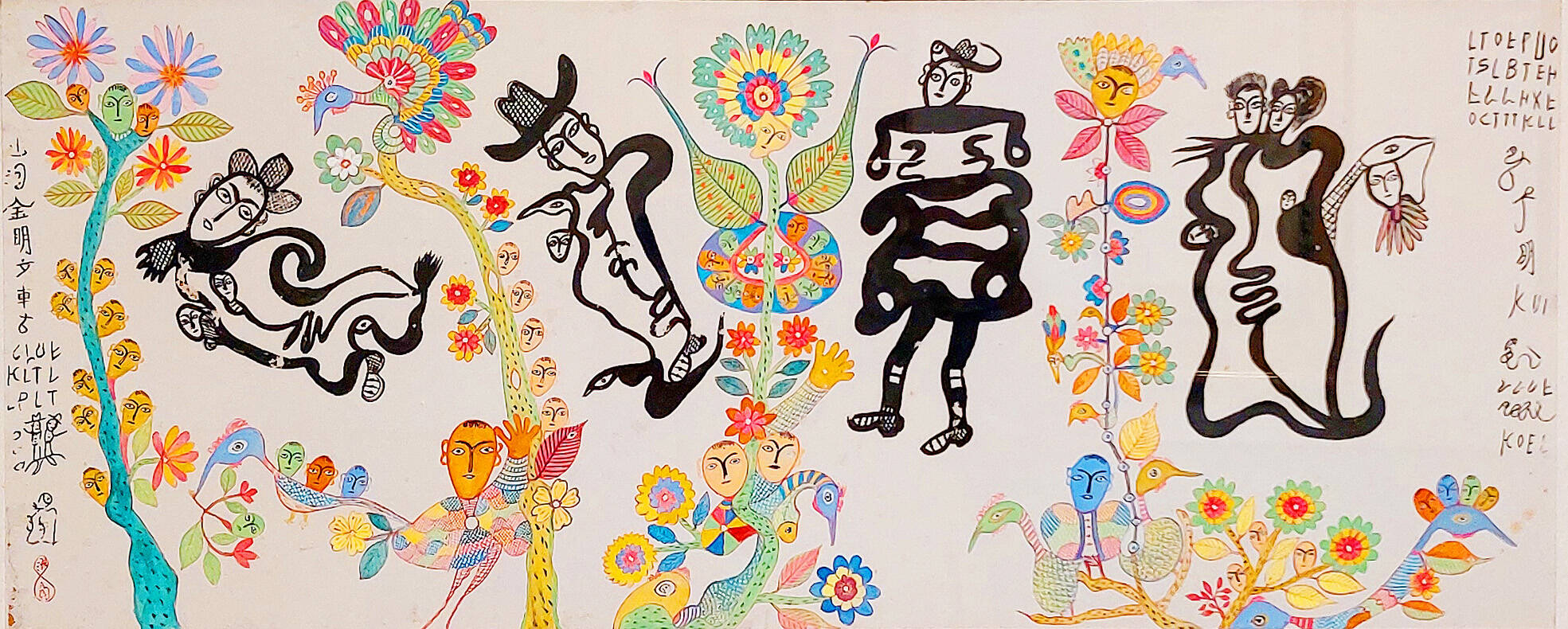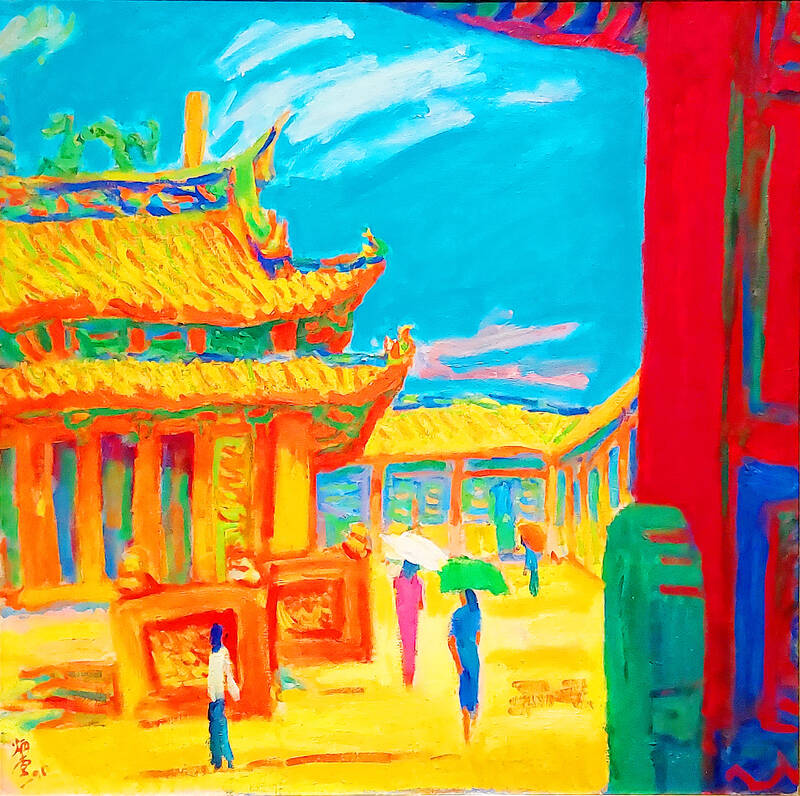Tainan Art Museum has put together an exhibition as part of its efforts to promote local artists. “Focus” features works by painters Hung Tung (洪通), Chang Ping-tang (張炳堂), Tsai Tsao-Ju (蔡草如) and photographer Hsu Yuan-fu (許淵富).
The collection of Chang’s works focus on the theme of temples, showcasing bold, vibrant colors and a style that eschews perspective in favor of a flat quality. In his painting Tainan Confucius Temple, a sunny courtyard under a blue sky is framed by a dark red passageway, placing the viewer inside one of the temple buildings looking outside. The warm, saturated colors are far from realistic, and reinforce the juxtaposition between spiritual and temporal spaces.
Visitors who complete viewing Chang’s colorful designs are met by Hsu’s stark, black-and-white creations adorning the gallery’s walls. Hsu, who started out as an amateur photographer, is known for his skill at manipulating light and shadows. To express the emotions of his subjects, Hsu focused on three main aspects of the body: the face, the hands and posture.

Photo: Doruk Sargin
The exhibition includes about 30 works by Hung, whose centennial was separately celebrated by the museum in 2020. This year’s feature on Hung is divided into three sections according to his different styles and sources of inspiration: “The Influence of Temples and Folk Art,” “Joyful Dreams of the Land,” and “Word-Paintings and Painted Words,” the latter of which showcases unique works featuring an invented language. Hung, who was illiterate, observed Chinese characters and the Latin alphabet to create symbols resembling them, and integrated them into his works.
Lastly, the exhibition showcases works by Tsai, who started out as a temple painter following the end of World War II and later stood out with his clear lines and carefully arranged compositions. He also employed anatomy, perspective and color theory in his works, and painted for more than 60 temples across Taiwan. His painting, Bo Le Judging a Horse, which won Tsai plaudits at the first post-war Taiwan Art Exhibition and encouraged him to further pursue fine arts, is on display at the “Focus” exhibition.

Photo: Doruk Sargin

Photo: Doruk Sargin

One of the biggest sore spots in Taiwan’s historical friendship with the US came in 1979 when US president Jimmy Carter broke off formal diplomatic relations with Taiwan’s Republic of China (ROC) government so that the US could establish relations with the People’s Republic of China (PRC). Taiwan’s derecognition came purely at China’s insistence, and the US took the deal. Retired American diplomat John Tkacik, who for almost decade surrounding that schism, from 1974 to 1982, worked in embassies in Taipei and Beijing and at the Taiwan Desk in Washington DC, recently argued in the Taipei Times that “President Carter’s derecognition

This year will go down in the history books. Taiwan faces enormous turmoil and uncertainty in the coming months. Which political parties are in a good position to handle big changes? All of the main parties are beset with challenges. Taking stock, this column examined the Taiwan People’s Party (TPP) (“Huang Kuo-chang’s choking the life out of the TPP,” May 28, page 12), the Democratic Progressive Party (DPP) (“Challenges amid choppy waters for the DPP,” June 14, page 12) and the Chinese Nationalist Party (KMT) (“KMT struggles to seize opportunities as ‘interesting times’ loom,” June 20, page 11). Times like these can

JUNE 30 to JULY 6 After being routed by the Japanese in the bloody battle of Baguashan (八卦山), Hsu Hsiang (徐驤) and a handful of surviving Hakka fighters sped toward Tainan. There, he would meet with Liu Yung-fu (劉永福), leader of the Black Flag Army who had assumed control of the resisting Republic of Formosa after its president and vice-president fled to China. Hsu, who had been fighting non-stop for over two months from Taoyuan to Changhua, was reportedly injured and exhausted. As the story goes, Liu advised that Hsu take shelter in China to recover and regroup, but Hsu steadfastly

You can tell a lot about a generation from the contents of their cool box: nowadays the barbecue ice bucket is likely to be filled with hard seltzers, non-alcoholic beers and fluorescent BuzzBallz — a particular favorite among Gen Z. Two decades ago, it was WKD, Bacardi Breezers and the odd Smirnoff Ice bobbing in a puddle of melted ice. And while nostalgia may have brought back some alcopops, the new wave of ready-to-drink (RTD) options look and taste noticeably different. It is not just the drinks that have changed, but drinking habits too, driven in part by more health-conscious consumers and